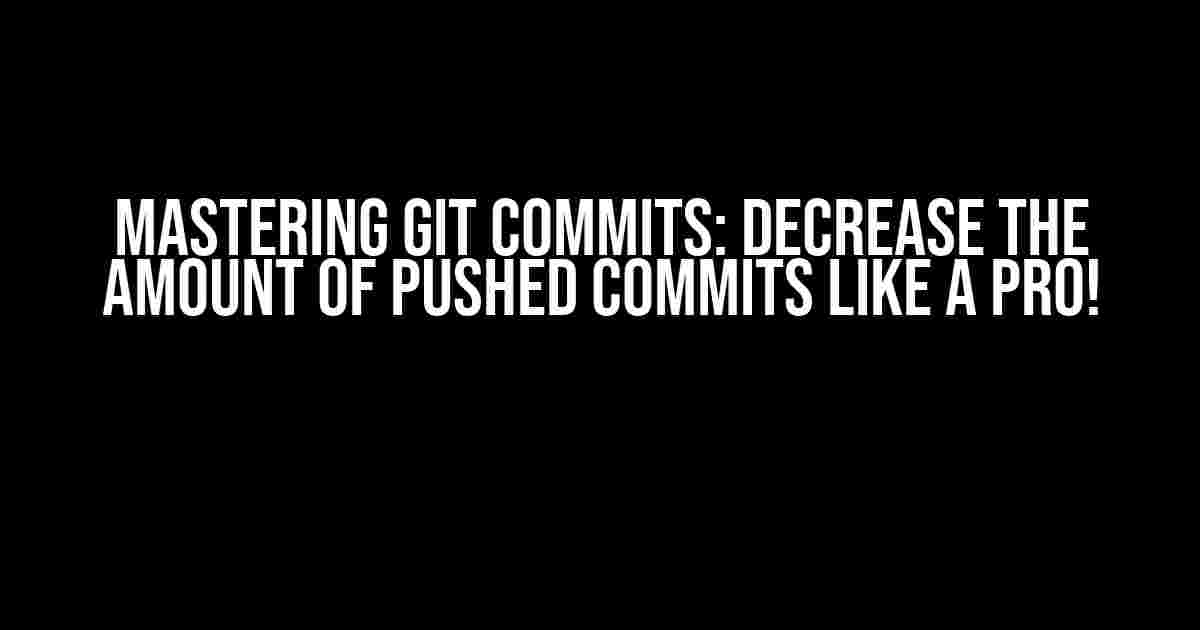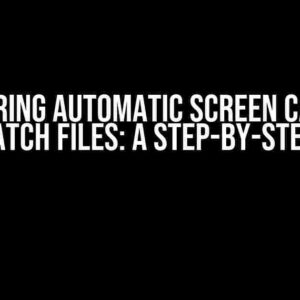Are you tired of cluttering your Git history with unnecessary commits? Do you want to maintain a clean and organized repository? Look no further! In this article, we’ll dive into the world of Git commits and explore the best practices to decrease the amount of pushed commits. By the end of this tutorial, you’ll be a Git commit master, and your repository will be a shining example of organization and efficiency.
Why Should You Care About the Number of Pushed Commits?
Before we dive into the nitty-gritty, let’s discuss why it’s essential to minimize the number of pushed commits. Here are a few compelling reasons:
- Readability and Maintainability: A cluttered Git history can make it challenging for developers to track changes, identify issues, and maintain the codebase.
- Collaboration and Communication: Excessive commits can lead to confusion among team members, making it harder to collaborate and communicate effectively.
- Performance and Scalability: A large number of commits can slow down Git operations, such as cloning, fetching, and pushing, which can impact performance and scalability.
Understanding Git Commits: The Basics
Before we explore strategies to decrease the amount of pushed commits, let’s quickly review the basics of Git commits.
A Git commit is a snapshot of your codebase at a particular point in time. When you commit changes, Git creates a new commit object that contains the following information:
- Commit message: A brief description of the changes made.
- Author: The person who made the changes.
- Date: The timestamp of the commit.
- Changes: The actual code changes.
There are three types of commits:
- Local commits: Commits made locally on your machine, not yet pushed to the remote repository.
- Pushed commits: Commits pushed to the remote repository, visible to other team members.
- Squashed commits: Commits that are merged into a single commit, eliminating unnecessary intermediate commits.
Strategies to Decrease the Amount of Pushed Commits
Now that we’ve covered the basics, let’s dive into the strategies to minimize the number of pushed commits:
1. Use `git add -p` and `git commit -p`
Instead of using `git add .` and `git commit -m “message”`, use `git add -p` and `git commit -p` to stage and commit changes incrementally. This approach allows you to review and select specific changes to commit, reducing the likelihood of unnecessary commits.
$ git add -p
$ git commit -p -m "Descriptive commit message"
2. Use `git squash` and `git rebase`
When working on a feature or fix, use `git squash` to combine multiple commits into a single commit. Then, use `git rebase` to reapply the squashed commit on top of the latest upstream changes.
$ git squash HEAD~5 # Squash last 5 commits
$ git rebase origin/master # Rebase on top of latest upstream changes
3. Use `git merge –squash`
When merging branches, use `git merge –squash` to create a new commit that combines all the changes from the merged branch. This approach eliminates unnecessary merge commits.
$ git merge --squash feature/branch
$ git commit -m "Merged feature/branch into master"
4. Use `git commit -a` with Care
Be cautious when using `git commit -a`, as it commits all changes, including unstaged files. Instead, use `git add -p` and `git commit -p` to stage and commit changes incrementally.
$ git add -p
$ git commit -p -m "Descriptive commit message"
5. Avoid Committing Unnecessary Files
Make sure to ignore files that shouldn’t be committed, such as:
- IDE configuration files
- Temporary files
- Log files
Use `.gitignore` files to ignore these files and prevent them from being committed accidentally.
$ cat .gitignore
*.tmp
*.log
.idea/
6. Use `gitk –all` and `git log` for Visualization
Use `gitk –all` and `git log` to visualize your commit history and identify areas for improvement.
$ gitk --all
$ git log --graph --oneline
Best Practices for Commit Messages
A well-crafted commit message is essential for maintainability and collaboration. Follow these best practices for writing effective commit messages:
| Best Practice | Description |
|---|---|
| Be concise | Keep commit messages short and to the point. |
| Use imperative mood | Write commit messages in the imperative mood, such as ” Fix bug” instead of “Fixed bug”. |
| Include relevant information | Provide additional context, such as issue numbers or relevant details. |
| Avoid unnecessary characters | Omit unnecessary characters, such as punctuation marks, at the end of the commit message. |
Conclusion
By implementing these strategies and best practices, you’ll be able to decrease the amount of pushed commits, maintain a clean and organized repository, and improve collaboration and communication among team members.
Remember, mastering Git commits takes time and practice. Start by incorporating one or two strategies into your workflow and gradually improve your commit hygiene.
Happy coding, and may your Git history be a masterpiece of cleanliness and elegance!
Frequently Asked Question
Get ready to simplify your Git workflow and reduce those pesky commit numbers!
Why do I need to decrease the number of Git commits?
Having too many commits can make your Git history look cluttered and overwhelming. By decreasing the number of commits, you can maintain a cleaner and more organized repository.
How can I reduce the number of commits in my Git repository?
You can use Git Squash or Git Rebase to combine multiple commits into a single commit. This will help reduce the number of commits and make your Git history more concise.
What is the difference between Git Squash and Git Rebase?
Git Squash rewrites the commit history, while Git Rebase replays the commits on top of another base. Git Squash is often used for local commits, while Git Rebase is used for shared branches.
What are some best practices for reducing commits in Git?
Use meaningful commit messages, group related changes together, and avoid committing unnecessary files. Also, use Git Hooks to enforce commit message formatting and prevent unnecessary commits.
Will decreasing the number of commits affect my Git workflow?
Not necessarily! With a few simple changes to your Git workflow, you can reduce the number of commits while still maintaining a seamless development experience. Just remember to communicate with your team and update your workflow accordingly.



